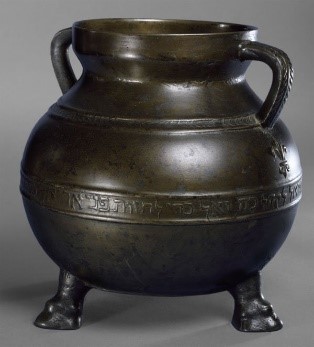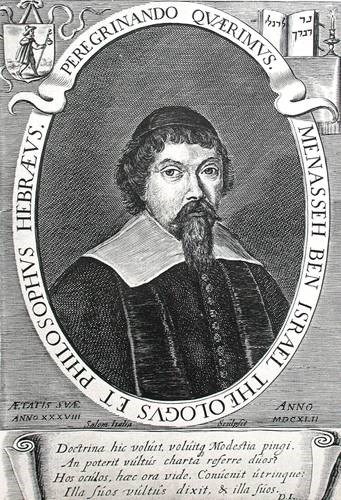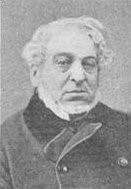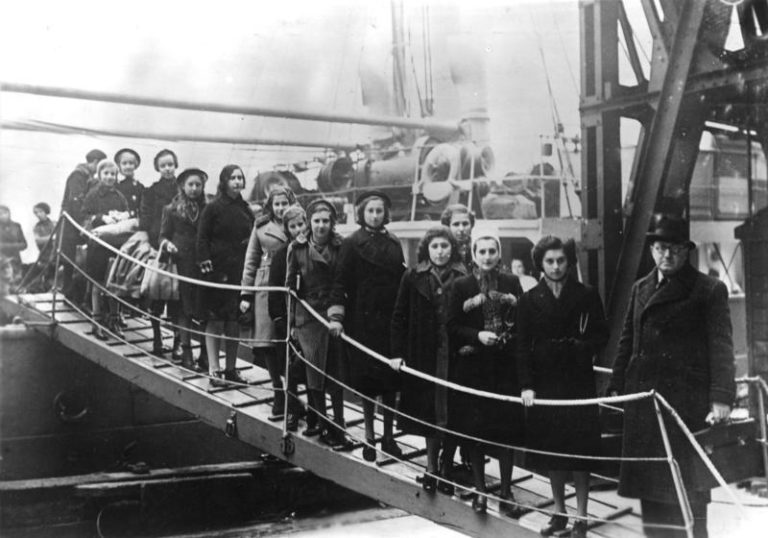Jewish Refugees Arriving in England
The history of Jews in England began in 1066 with an invitation. William the Conqueror had just won the Battle of Hastings and the Normans lay claim to England. The new king wanted the skills and capital of the Jewish people to benefit his fledgling kingdom. He invited a group of Jews living in Rouen, Normandy (modern day France) to come to England. William saw the Jewish people only as an economic boon that could be leveraged in his country’s favor.
Jew’s primary role in England was to act as moneylenders. It was forbidden for Christians to loan money with interest (the sin of usury), so they relied on Jews to do so. Their moneylending became crucial to the functioning of England’s economy. Many nobles, barons, and other members of the royal court relied on loans from Jews in order to purchase castles and pay dues to the crown. Furthermore, wars and journeys of exploration were similarly funded.
The unique and precarious situation of medieval Jews in England was codified under the rule of King Henry I. They weren’t true English citizens, instead functioning as royal serfs, a sort of servant/property of the king. Their position came with benefits such as free use of all the royal roads, special legal status, the right to use royal castles and tunnels for protection, and more. In return they paid higher taxes, gave what they earned through usury back to the crown when they died. Their lives and status were at the current king’s whims. For a while the Jews prospered under this system. They built communities in towns across England and by 1168 it was estimated that the Jewish community possessed a quarter of the wealth of the entire country.

The Bodleian Bowl, an Artifact of Medieval Jews Living in England
The late 1100s saw the rise of increasingly violent anti-Semitism. Much of this bigotry had rooted a few decades earlier in 1144 when the mutilated body of a young boy named William was found. Though there was no evidence pointing to whom specifically committed the heinous act, the Jews were blamed. Little came of the tragedy until 5 years later, when in 1149, a knight was tried for killing a Jewish banker to whom he owed money. In court, the knight’s defense was that since the Jews as a collective were never punished for William’s murder, no Christian should be punished for killing Jews. No verdict was reached and the knight walked free. A year later, in 1150, a monk named Thomas of Monmouth wrote a book further highlighting how the Jews had killed young William. Thomas took things a step further saying that Jews had an insatiable need for the blood of Christians. From his writing the false myth of blood libel was born, these hateful lies spread like wildfire across Europe. Anytime a child disappeared or died under mysterious or accidental circumstances the Jews were blamed. This led to many riots and massacres against the Jewish people.
Anti-Semitic sentiments were further stirred up by the crusades. Taking back the holy lands increased the population’s Christian zealotry and their dislike of those that didn’t share their faith
Jews, in particular,were seen as being responsible for Christ’s death. Throughout the years the papacy issued edicts calling for increasing restrictions on the rights of Jews. Furthermore, through their role as moneylenders earned the ire of those indebted to them. The nobles and barons of England owed the Jews the most and thus hated them the most and leveraged their political clout to hurt them in any way they could.
One of the worst anti-Semitic riots occurred in March of 1190. A massive and violent riot sprung up in York, spurred on by nobles who hoped to use it as a chance to wipe out their debts. The entire Jewish population of York (about 150) fled to the local royal castle. The castle was surrounded and besieged by the rioters. Ultimately, the Jews choose to kill themselves rather than be forcibly baptized and violently murdered by the mob.
In addition to violent anti-Semitism, Jews also faced economic pressures. The English monarchy levied increasingly high taxes on the Jews. When Jews couldn’t pay or objected to the disproportionate demands, they were subject to harsh punishments.
In 1253, King Henry III issued the first Statute of Jewery. This royal edict codified the anti-Semitic sentiment held in England at the time. Its biggest component was requiring that Jews always wear a clearly visible badge on their clothing so they could be identified as Jewish. The statute also said that no new synagogues could be built, barred most interactions between Jews and Christians, restricted the ability of Jews to live outside of Jewish communities, and even required Jewish services be held in whispers so that any passing Christians wouldn’t have to hear them.
In 1275, King Edward I issued the second Statute of Jewery which placed even more restrictions on the Jews of England. The biggest of which was outlawing Jews from practicing usury and forgiving many of the debts they were owed. By banning the Jews from money lending, Edward effectively cut them off from their livelihood with no reasonable means for them to earn enough money to support themselves and their families. Many Jews saw no choice but to turn to crimes like coin cutting and highway robbery. In 1278, there were more than 600 Jewish men arrested and imprisoned, many of them were hanged.
The anti-Semitism in England came to culmintated in 1290. On July 18th, King Edward issued the Edict of Expulsion. It stated that all the Jews living in England must leave by All Saint’s Day (November 1st) of that year. A small number of Jews stayed in England either converting to Christianity or keeping their faith a secret. The remaining 4,000-16,000 Jews living in England left, returning to the European mainland and settling in new countries. Jews would remain officially banned from England for over 350 years.

Menasseh Ben Israel
The movement to allow Jews to settle in England once more was led by Menasseh Ben Israel; a Rabbi, writer, and printer from Amsterdam. He wanted the Jews to be able to return to England because he believed it would hasten the arrival of the Messiah. In 1653, Israel and a few other rabbis visited England to rally support for the idea of Jews returning. They found an unexpected ally in Oliver Cromwell.
Cromwell had seen the economic benefits Jews living in Amsterdam had brought to the Netherlands and wanted the same for England. Britain’s economy had been devastated by civil war and the prospective commerce Jewish merchants could bring in was appealing. Furthermore, there was a popular belief that the second coming of Christ could not occur until Jews were living in all parts of the world.
In 1655, Israel petitioned the British Council of State that Jews be allowed to resettle in England. In response, Cromwell convened the Whitehall Conference; a gathering of merchants, lawyers, and clergyman, to discuss allowing Jews back into England. Though the conference did not reach a unified conclusion, the lawyers in attendance pointed out there was nothing illegal about allowing Jews to return. There was no official policy change or new law, just a verbal promise from Cromwell, and in 1656 Jews were allowed to settle in London once more.
Soon after Cromwell’s promise around 300 Sephardim (Spanish and Portuguese) Jewish merchants settled in London. Thus, began a new chapter for the Jews of England. There were attempts by businessmen, Christians, and aristocrats to re-expel them but the economic boons they brought were too good to refute and England’s new Jewish community was allowed to stay. However, antinti-Semitism persisted and there were laws branding Jews less than citizens and limiting their rights. However, their place in British society was far more stable, and slowly, through the centuries, they would gain more rights and opportunities.

Interior of Bevis Marks
In 1701, Bevis Marks, the first purpose-built synagogue in England was constructed. The synagogue still stands today and is the only building in Europe where Jewish worship has continued uninterrupted for over 300 years.
During the Jacobite uprising of 1745, the Jews provided both volunteers and financial aid to the defense of London. In 1753, as a reward for their loyalty, the Jewish Naturalization law was passed by parliament, allowing Jews to become naturalized. Public outrage to the law was so immense that it was repealed in 1754.
Over the course of several decades Jews would rise to new ranks in British society and the laws restricting them were abolished. In 1837, Queen Victoria knighted Jewish banker and philanthropist Moses Haim Montefiore, the first Jew to be knighted in hundreds of years. In 1841,Isaac Lyon Goldsmid became the first Jew to hold a heredity title when he was given the title of baronet. In 1846, laws that limited Jews’ ability to enter churches and required them to adhere to a specialized dress code were repealed.

Lionel de Rothschild
In 1847, Lionel de Rothschild was the first Jew to be elected to the British House of Commons. However, all members of parliament were required to take a Christian oath in order to be seated and Rothschild refused. It would take more than10 years and 2 re-elections before he could take his rightfully earned seat in 1858. In 1855, Sir David Salomons was the first Jew to become Lord Mayor of London. And, in1876, Benjamin Disraeli became what many consider to be the first Jewish Prime Minister. Disraeli was born a Jew, however his father had him baptized into the Anglican church at age 13. While he was a practicing Christian, Disraeli was open about his Jewish roots. By 1882 all restrictions on the Jewish people of England had been lifted and the Jewish community had grown to around 46,000.
The period between 1880 and 1920 saw a huge influx of Jews into England. Jews from Germany, Poland, and Russia came to England fleeing the pogroms that had overtaken their homes. By 1919 the Jewish population of England had grown to 250,000. Generally speaking, the modern English were accepting of Jews and their culture. In turn, Jews often anglicized their names and cultures. They mimicked English traditions like the British Scouts with their own Jewish Lads Brigade. In 1936, when pro-fascist anti-Semitic group decided to march through a Jewish neighborhood, anti-fascist demonstrators defended the Jewish residents and drove off the marchers.

Soldiers in the Jewish Brigade Group
During World War I, there were 50,000 Jews who fought in the British army. There was even an all Jewish regiment called the Jewish Legion. In the 1930s, the British did not fully open their arms to Jewish refugees of Nazism, but they did permit around 100,000 settle in England. When World War II began tens of thousands of British Jews volunteered for the war effort. Britain also recruited Jews from Mandatory Palestine to form the Jewish Brigade Group. Many Polish Jews ended up fighting alongside the allies under British military command, these soldiers were all eligible to settle in the United Kingdom after the war.
While Great Britain presently has the 6th largest Jewish population in the world, the current numbers are a substantial decline from their peak in the 1950s. Since its founding many British Jews have left to live in Israel. The Jewish population of England has further declined from intermarriage. Anti-Semitism and violence against Jews beganising in the early 2000s and remains a pressing issue today, driving fears that it will push even more of the country’s Jewish population to move elsewhere.
Further Reading:
In 2021 archaeologists found evidence that Jews living in medieval England kept kosher. You can read about it here.
Fun Fact: Other famous British Jews include:
- Harold Abrahams: a gold medal Olympiad in the 100-meter sprint whose life was dramatized in the academy award winning film Chariots of Fire.
- Daniel Mendoza: a boxer in the late 1700s who became the boxing champion of England and revolutionized boxing with his scientific fighting style and book The Art of Boxing.
Ernst B Chain: a biochemist who won the Nobel prize alongside Howard Florey and - Alexander Fleming for their work on discovering penicillin’s therapeutic properties, its chemical structure, and how to isolate and produce it.

Fish and Chips
Fun Fact: A surprising fact about British fare is that fish and chips had Jewish origins, well at least the fish part. Sephardic Jews from Spain and Portugal had long eaten a dish consisting of white fish fried in a thin layer of batter. It was specifically made for Shabbat as they felt the frying process preserved the fish just long enough that it could be cooked beforehand and eaten when work was prohibited. When these Jews came to England, they brought their fish recipe with them. It was a big hit amongst British Catholics who ate fish on Fridays. From there “Fish in the Jewish Manner” became a mainstream delicacy.
Peak Population of Jews in England: 1951 when there were approximately 420,000.
Population of Jews in England Today: There are between 269,000 and 290,000 Jews living in the Great Britain today.
Population of English Jews in Israel: Approximately 41,000






